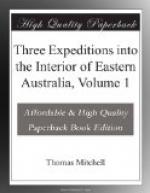Depending chiefly on the river for subsistence, they do not wander so much as those who hunt the kangaroo and opossum in the higher country near our colony. Hence the more permanent nature of the huts on the Darling; and it would appear that different tribes occupy different portions of the river. The Spitting tribe desired our men to pour out the water from the buckets, as if it had belonged to them; digging at the same time a hole in the ground to receive it when poured out; and I have more than once seen a river chief, on receiving a tomahawk, point to the stream and signify that we were then at liberty to take water from it, so strongly were they possessed with the notion that the water was their own.
We saw no kangaroos lower down than Dunlop’s range, neither did we see any emus. In the red sandhills were many burrows of the wombat, but these also became scarce as we proceeded downwards.
SINGULAR HABITS OF A RAT.
A species of rat* was remarkable for the ingenious fabric it raised to secure itself from the native dog or birds of prey. The structure consisted of a rick or stack of small branches, commonly worked around and interlaced with some small bush, the whole resembling a pile laid for one of the signal fires so much used by the natives. As these heaps of dead boughs drew the attention of our dogs we at length examined several of them and always found a small nest in the centre occupied by the same kind of rat. This animal had ears exactly resembling those of a small rabbit, soft downy wool and short hind legs; indeed but for the tail it might have passed for a small rabbit.
(Footnote. Conilurus constructor. Ogilby.)
SECURITY OF A SPECIES OF ANTS.
The work of an ant peculiar to the country also attracted our attention. Instead of a mound these insects made a habitation or excavation under the surface, about six feet in diameter, and it was quite smooth, level and clean, as if constantly swept. It was also nearly as hard as stone; and the only access to it was by one or two small holes. This surface was, to us, on first advancing into the interior, one of its wonders. Thus this variety of ant dwells securely at some depth below, for nothing less than a pickaxe can penetrate to the larvae; but those of another variety of the common kind which construct mounds are eaten by the native females and children, who carry wooden shovels for the purpose of digging them out.
BIRDS.
The bronze-wing pigeon was here as elsewhere the most numerous of that kind of bird. Next in abundance was the crested pigeon which seems more peculiar to these low levels. There were large flocks of a brown pigeon with a white head, and not an uncommon bird elsewhere; also a small species of dove with very handsome plumage. The large black cockatoo was sometimes seen, and about the riverbanks the common white cockatoo with yellow top-knot (Plyctolophus




